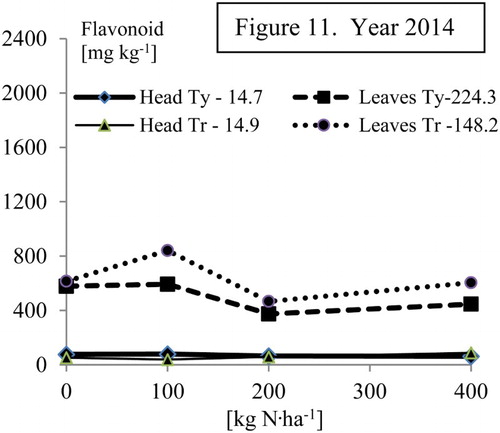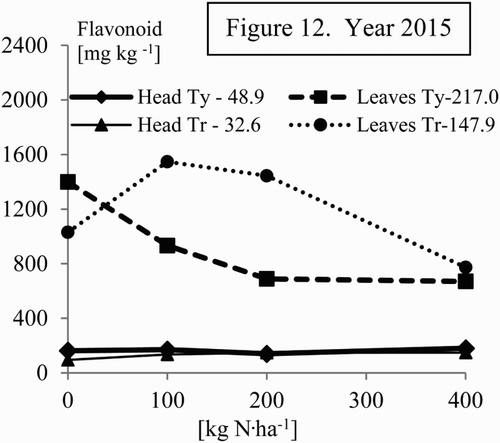ABSTRACT
The effect of different nitrogen treatments (100–400 kg N ha−1) on yield and quality of marketable cabbage heads and outer green leaves (waste fraction) of two cultivars of Brassica oleracea convar. capitata var. alba L. grown in two years field experiment was studied. During harvest, the marketable cabbage heads and the outer leaves (not adjacent leaves of cabbage) were removed; total and marketable yield of cabbage were evaluated as well as nutritive value was determined based on content of some components, that is, dry matter, ascorbic acid, soluble polyphenols, total flavonoids, nitrates, total nitrogen and antioxidant activity using 1,1-diphenyl-2-picrylhydrazyl (DPPH). The study showed a significant effect of nitrogen fertilization on the total and marketable yield of the tested cultivars of cabbage. The weight of total cabbage heads was increasing according to higher nitrogen fertilization from 100 up 400 kg N ha−1 for both cultivars. The outer leaves of cabbage characterized by a significantly higher nutritive value compared with marketable head, which is supported by several-fold higher content of total flavonoids, soluble polyphenols and over the 100% increase in ascorbic acid content. Although the outer green leaves of cabbage are discarded after harvesting, they possess high nutritive potential which can be practically used or transformed into an added value product.
Introduction
White head cabbage (Brassica oleracea convar. capitata var. alba L.) is one of the most important vegetable species in Poland, being grown on a total area of 25,000 ha (CSOP Citation2014) with a production volume of 1100 thousand ton. This makes Poland the first producer of white cabbage in the European Union. White cabbage is also a very popular vegetable in the world consumed raw in coleslaw or after processing, mostly as conserved or fermented (sauerkraut) forms. It plays an important dietetic role because of a high content of vitamin C, potassium, organic acids, glucosinolates and fibers (Bartoszek et al. Citation2002; Singh et al. Citation2006; Jahangir et al. Citation2009; Kramchote et al. Citation2012).
Nitrogen fertilization during cultivation period can affect the quality of cabbage, including the reduction of sugars and ascorbic acid content, as well as the increase of the content of nitrates (Everaarts & de Moel Citation1998; Freyman et al. Citation1991; Komiyama et al. Citation1999). According to Hatano et al. (Citation2003), nitrogen fertilization at a dose of 600 kg ha−1 increases the nitrate (V) in cabbage by about 25% compared with a dose of 300 kg ha−1. Tarata et al. (Citation1995) reported that high doses of nitrogen fertilization (400 kg ha−1) increase the content of chlorophyll in the leaves of the cabbage by 70–80%. Freyman et al. (Citation1991) studied the effects of increasing rates of N application (0, 100, 200, 300, 400 and 500 kg ha−1) on yield and selected chemical constituents of a winter white cabbage commonly grown in south coastal British Columbia. Their study has indicated that fertilization of winter white cabbage with increasing N doses resulted in slight decreases of ascorbic acid and sugar content and increases of glucose and fructose contents, while yields of cabbage were increased markedly. Research of Biesiada et al. (Citation2010) aimed at determination of the effect of increasing nitrogen fertilization dose (50–250 kg ha−1) on the content of nutritive compounds and antioxidant activity of red cabbage. They have found that the increase in nitrogen dose did contribute to increased nitrates level and to the decrease in the contents of dry matter, extract, reducing and total sugars. At the same time, the highest content of vitamin C accumulated red cabbage fertilized with nitrogen in the dose of 250 kg N ha−1. Experiments of Kołota and Chochura (Citation2015) related to N fertilization of white cabbage have revealed that enhancement of N dose from 150 to 300 kg N ha−1 was beneficial for total yield of heads as well the increment of nitrates accumulation and decrease of Ca content in cabbage heads.
White cabbage is a crop with a high nitrogen demand. General recommended fertilizer amounts are between 200 and 500 kg N ha−1 for optimal growth and high yields (Zebarth et al. Citation1991; Sørensen Citation1993; Sanchez et al. Citation1994). Under temperate climate conditions, nitrogen requirements of white cabbage are estimated for the 240–320 kg N ha−1 range for a mean cultivation period of 65–150 days (Feller et al. Citation2011). According to Polish recommendations, late grown cultivars of cabbage should be fertilized with nitrogen doses of 240 kg ha−1 (Sady Citation2000), while the Dutch recommend the use of 300 kg N ha−1 before planting and 50 kg ha−1 after 5–6 weeks from transplantation (Sieling Citation1992). High doses of nitrogen during fertilization can cause loose structure of head cabbage leaves and lower suitability of heads for storage and fermentation (Rumpel Citation2002).
In general, the outer leaves of white head cabbage do not matter in food production, such as coleslaw or sauerkraut. Only the part of the leaves of round compact cabbages is exposed to sun light and they become green. In most cases, however, up to 40% of outer leaves and core of cabbages are discarded (Nilnakara et al. Citation2009) and are mainly used as a green fertilizer or as animal feed. Although the outer green leaves of cabbage are discarded and treated as wastes, they may be transformed into an added value product. The production of dietary fiber powder associated with antioxidant activity produced from cabbage outer leaves was developed by Nilnakara et al. (Citation2009). Jongaroontaprangsee et al. (Citation2007) produced high dietary fiber powder from outer leaves of cabbage and reported that the powder contained approximately 41–43% total dietary fiber and possessed high water holding capacity and swelling capacity making the product attractive for many food applications. Also recovery of bioactive compounds from outer leaves is becoming attractive for the preparation of food additives. For this, new methods of compound extraction were developed, for example, microwave-assisted extraction of bioactive compounds from cabbage outer leaves via the application of ultrasonic pretreatment (Pongmalai et al. Citation2015).
The aim of our experiments conducted in 2014 and 2015 was to determine the effect of different nitrogen fertilization (100–400 kg N ha−1) on yield and quality of marketable cabbage heads and outer green leaves of Brassica oleracea convar. capitata var. alba L. cultivated in the field.
Material and methods
Field experiment and plant material
The experiments were carried out at the Experimental Field of the Research Institute of Horticulture at Skierniewice, Poland, using two cabbage (Brassica oleracea var capitata L.) cultivars: Transam F1 and Typhoon F1 and four nitrogen fertilization treatments: A1 (0 kg N ha−1), A2 (100 kg N ha−1), A3 (200 kg N ha−1) and A4 (400 kg N ha−1). The experimental design was a randomized block with four replicates for each N treatment and cultivar, each of about 18 m2 area. Preplant N fertilization occurred on 26th May 2014 and 22nd May 2015. At this stage, the A4 treatment consisted of 200 kg N ha−1, while a second application of the same rate was done as a side dress fertilization on 3rd July 2014 and 2nd July 2015. No side dress N fertilization for A2 and A3 treatments was applied. Transplants of cabbage were produced in greenhouse. Seeds were sown on 25th April 2014 and 24th April 2015 to the multi-cell trays ‘Vefi’ 96, filled with peat substrate ‘Select’ from Klasmann–Deilmann. Mean air temperature was maintained between 20°C and 23°C (day) and 17°C and 18°C (night) during the course of transplant production. Transplants at the stage of 5–6 leaves were transplanted to the field on 4th of June 2014 and 3rd June 2015. Plant distances were 0.6 and 0.5 m within and between rows, respectively. In both years of cabbage growing, all plants were irrigated according to current needs. The weather conditions of global irradiance, total rainfall and mean air temperature from the beginning of the vegetative period to the end of trial are given in (Meteorological &Weather Station, Skierniewice, Poland).
Table 1. Meteorological data during growing season 2014 and 2015.
Cabbage heads were harvested on 23rd October 2014 and 21st October 2015. During harvest of cabbage heads, the outer leaves (green, not adjacent leaves of the head) were removed as a waste fraction of cabbage; their weight was measured, total and marketable yield of cabbage were evaluated.
Chemical analysis of outer leaves and marketable cabbage heads
The nutritive value of marketable cabbage (heads without outer leaves) and removed outer leaves were determined based on content of dry matter, ascorbic acid, soluble polyphenols, total flavonoids, nitrates and total nitrogen. Also total antiradical activity of cabbage heads and waste fractions was determined. Following methods of analysis were applied: dry matter – gravimetric method by drying up to 102°C; ascorbic acid – by Tillmans method (ISO Citation1984); soluble polyphenols – by Folin-Ciocalteu method (Vinson et al. Citation1998); total flavonoids – spectrophotometric method – by Zhishen et al. (Citation1999) and Eberhardt et al. (Citation2000); antiradical activity – using 1,1-diphenyl-2-picrylhydrazyl method (Lee et al. Citation1995); nitrates – Ion-Selective Electrodes method (model 407A Orion Research); nitrogen – by Kjeldahl method (AOAC 955.04D).
Two factorial ANOVA and Tukey’s HSD test (p = .05) were used for statistical analysis of data. All calculations have been done with Statistica v.13 (Dell Inc. Citation2016) software.
Results and discussion
Cabbage yield
The study showed a significant effect of nitrogen fertilization on the total and marketable yield of the tested cultivars of cabbage cultivated in 2014 and 2015 ().
Table 2. Effect of nitrogen doses on total and marketable yield of cabbage.
Total yield of both cultivars of cabbage increased significantly with increasing dose of nitrogen, that is, up to a rate of 400 kg N ha−1. Marketable yield was also the highest at a rate of 400 kg N ha−1; however, the total and marketable yields in 2014 were not significantly different from the yield obtained at a dose of 200 kg N ha−1. It supports the earlier experiments and observations (Everaarts & de Moel Citation1998) that the recommended nitrogen fertilizer amount of approximately 350 kg N ha−1 for cabbage cultivation can be reduced without decreasing the yield potential. Additionally, high nitrogen fertilization can negatively influence on cabbage head quality by high nitrate concentrations in the edible parts of the plant (Maynard & Barker Citation1972). There were no significant differences in the total yield and marketable yield between studied cultivars in the year 2014. In year 2015, the higher yields of cabbage for higher nitrogen treatments were observed but the differences between effect of nitrogen doses (100–400 kg N ha−1) on total and marketable yield of cabbage were not statistically proved. Basing on empirical data, the total yield of cabbage in 2015 was by about 33% lower compared to that one in 2014 and it can be possibly explained by different weather condition in both years (). Two factorial analyses of variance have shown that there was no significant effect of the factorial scheme on cabbage yield. The effect of nitrogen fertilization on higher yield of cabbage was already earlier documented (Freyman et al. Citation1991, Sturm et al. Citation2010). Also the method of nitrogen application does not significantly have an effect on the cabbage yield (Kaniszewski et al. Citation1999).
Cabbage fractions – marketable heads and outer leaves
The weight of total cabbage head (marketable head + outer leaves) was increasing in 2014 according to higher nitrogen fertilization from 100 up 400 kg N ha−1 for both cultivars (). The unexpected decrease in weight of total cabbage head between control and 100 kg N ha−1 treatment was observed for Transam F1 in 2015. The similar effect of increasing N treatment was observed for weight of outer leaves. The outer leaves of cabbage heads of tested cultivars Transam F1 and Typhoon F1 made from 24.96% up to 29.69% of total cabbage head weight in 2014 and from 32.92% up to 36.82% of total cabbage head weight in 2015 depending on cultivar and nitrogen treatment.
Table 3. Influence of nitrogen fertilization on weight of total cabbage heads and outer leaves.
With the increase of nitrogen fertilization during cultivation period of both cultivars, the weight of outer leaves (as % of total head weight) had tendency to decrease in 2014 and tendency to increase in 2015. The opposite tendency in 2015 was probably an effect of weather conditions, higher temperature in August–September compared to the year 2014 ().
Quality of marketable heads
The increase of nitrogen fertilization up to 400 kg N ha−1 induced a slight decrease of dry matter content in the marketable heads from 10.71% to 9.67% for Transam F1 and from 10.12% to 9.70% for Typhoon F1 ( and ). According to earlier studies of other authors, nitrogen fertilization caused a considerable decline of dry matter content in white cabbage (Gajewski & Radzanowska Citation2004; Sturm et al. Citation2010) or in carrots (Smolen & Sady Citation2009) who studied the effect of various nitrogen fertilization on the dry matter content in carrot roots (Daucas carota L.). The effect of nitrogen on vegetable crop production was studied by Sorensen (Citation1999) and it was shown that increased N supply decreased the dry matter content in vegetable crops – broccoli, carrot, cabbage and leek.
Figure 1. Effect of N treatment on dry matter content (%) in cabbage heads and outer leaves, cv. Typhoon F1 (Ty) and Transam F1 (Tr). HSD (p = .05) in legend.
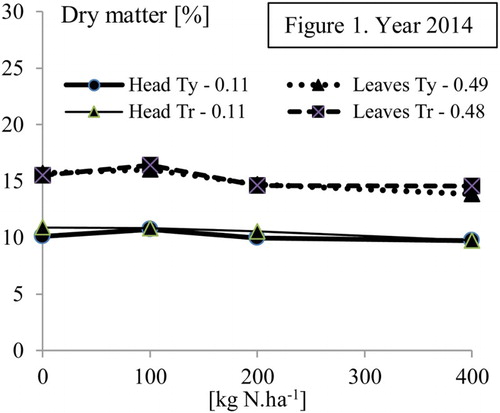
Figure 2. Effect of N treatment on dry matter content (%) in cabbage heads and outer leaves, cv. Typhoon F1 (Ty) and Transam F1 (Tr). HSD (p = .05) in legend.
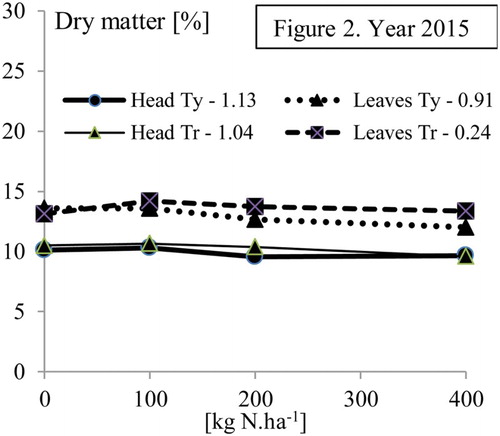
Total nitrogen and nitrates contents in the marketable heads of cabbage cv. Typhoon F1 and cv. Transam F1 were positively correlated to N rates (). The total nitrogen content in the marketable cabbage was increasing when the fertilization rates was increased from 100 up to 400 kg ha−1. Lowest nitrogen fertilization – rate of 100 kg N ha−1 – resulted in a low nitrate content in marketable cabbage while a highest fertilization – 400 kg N ha−1 – caused a several-fold increase of nitrates content, from 47.6 up to 438.6 mg NO3 kg−1 (Transam F1) in 2014, and from 77.9 up to 312.1 mg NO3 kg−1 (Typhoon F1) in 2014.
Figure 3. Effect of N treatment on total nitrogen content (% d.m.) in cabbage heads and outer leaves, cv. Typhoon F1 (Ty) and Transam F1 (Tr). HSD (p = .05) in legend.
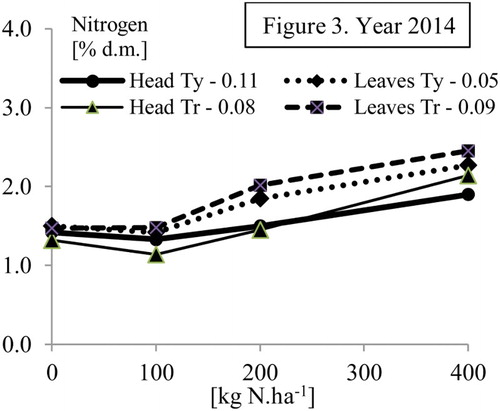
Figure 4. Effect of N treatment on total nitrogen content (% d.m.) in cabbage heads and outer leaves, cv. Typhoon F1 (Ty) and Transam F1 (Tr). HSD (p = .05) in legend.
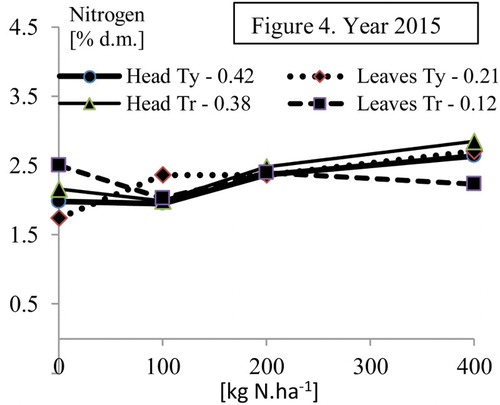
Figure 5. Effect of N treatment on total nitrates content (mg kg−1 f.w.) in cabbage heads and outer leaves, cv. Typhoon F1 (Ty) and Transam F1 (Tr). HSD (p = .05) in legend.
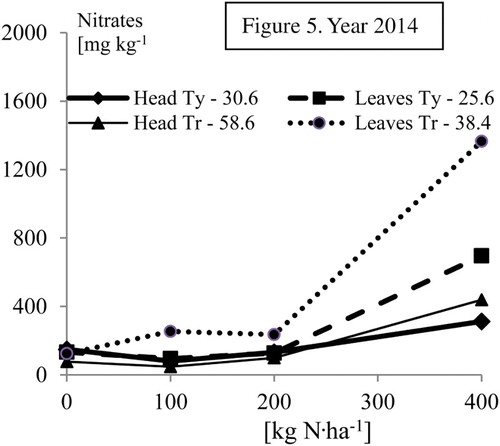
Figure 6. Effect of N treatment on total nitrates content (mg kg−1 f.w.) in cabbage heads and outer leaves, cv. Typhoon F1 (Ty) and Transam F1 (Tr). HSD (p = .05) in legend.

Our results confirm what was also found by various authors, who analyzed the total nitrogen and nitrates contents in cabbage (Hatano et al. Citation2003; Gajewski & Radzanowska Citation2004; Turan & Sevimli Citation2005; Sturm et al. Citation2010; Chohura & Kołota Citation2014), in carrot (Smolen & Sady Citation2009), in Chinese cabbage and spinach (Chen et al. Citation2004). Some other experiments have shown that the form of nitrogen supplied for fertilization can also have an impact on nitrates content in vegetables (Kaniszewski & Rumpel Citation1998; Turan & Sevimli Citation2005; Engelbrecht et al. Citation2010).
Our experiments have shown the range of ascorbic acid content in non-fertilized marketable cabbage 39.8–48.9 mg 100 g−1 for cv. Transam F1 and 51.9–55.2 mg 100 g−1 for cv. Typhoon F1 depending on the year of cultivation ( and ). The previous experiments have shown the vitamin C content in cabbage on the level of 32 (Chu et al. Citation2002) and 27.32 mg 100 g−1 f.w. (Kurilich et al. Citation1999). There was a tendency to higher ascorbic acid content in cabbage heads cv. Typhoon F1 compared to cv. Transam F1 in both years of cultivation, as well as positive effect of N fertilization (200 kg N ha−1) on slight increase of ascorbic acid content in cabbage heads. Gajewski and Radzanowska (Citation2004) have found no significant differences in ascorbic acid content between cabbage fertilized with nitrogen rate 150, 200 and 250 kg N ha−1. The other authors also suggest that there is no effect of increased nitrogen fertilization on the content of ascorbic acid in cabbage (Kołota & Adamczewska-Sowińska Citation2009), and also in cauliflower and broccoli (Lisiewska & Kmiecik Citation1996) or leaf lettuce (Chohura & Kołota Citation2011).
Figure 7. Effect of N treatment on ascorbic acid content (mg 100 g−1 f.w.) in cabbage heads and outer leaves, cv. Typhoon F1 (Ty) and Transam F1 (Tr). HSD (p = .05) in legend.
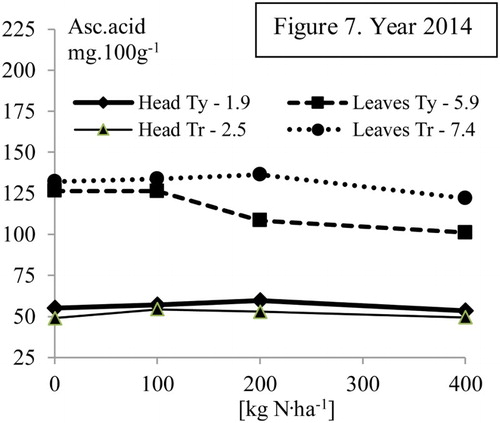
Figure 8. Effect of N treatment on ascorbic acid content (mg 100 g−1 f.w.) in cabbage heads and outer leaves, cv. Typhoon F1 (Ty) and Transam F1 (Tr). HSD (p = .05) in legend.

There were no apparent effect of increasing N fertilization on the content of polyphenols ( and ) and flavonoids ( and ) in marketable cabbage heads.
Figure 9. Effect of N treatment on total polyphenols content (mg 100 g−1 f.w.) in cabbage heads and outer leaves, cv. Typhoon F1 (Ty) and Transam F1 (Tr). HSD (p = .05) in legend.
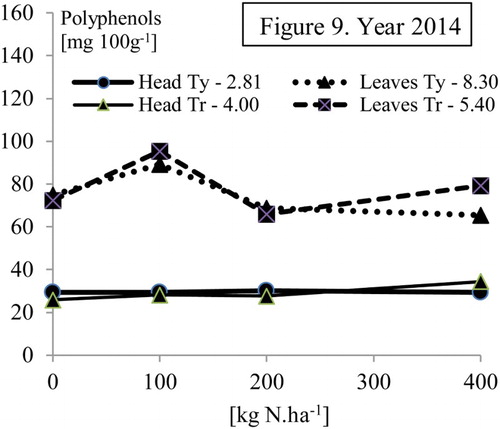
Figure 10. Effect of N treatment on total polyphenols content (mg 100 g−1 f.w.) in cabbage heads and outer leaves, cv. Typhoon F1 (Ty) and Transam F1 (Tr). HSD (p = .05) in legend.
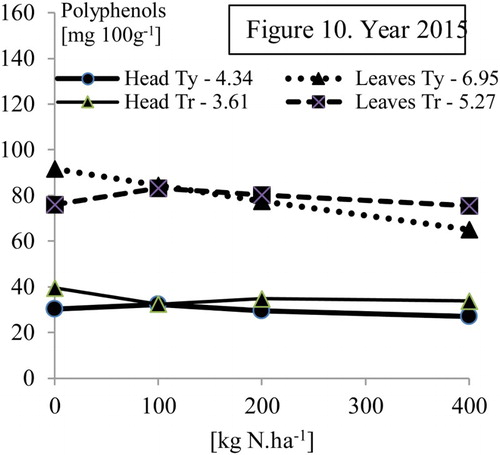
Quality of outer leaves of cabbage
The outer leaves of cabbage were characterized by significantly higher nutritional value compared with marketable head, which is supported by several-fold higher content of total flavonoids, soluble polyphenols and over the 100% increase in ascorbic acid ().
Table 4. Quality traits of marketable cabbage heads and outer leaves.
The range of dry matter content in outer leaves 13.29–15.17% was higher than in marketable heads 10.10–10.33% for both cultivars and years of cultivation ().
The outer leaves of cabbage contained in both cultivars by average 80.02–123.3 mg 100 g−1 f.w. of ascorbic acid but the marketable heads 47.06–53.86 mg 100 g−1 depending on the year of cultivation. In studies of Nilnakara et al. (Citation2009) on cabbage, the concentration of vitamin C in outer leaves was found to be 31.97 mg 100 g−1 f.w. or 532.85 mg 100 g−1 d. m.
The outer leaves of cabbage were characterized with significantly higher content of flavonoids (565.2–1060.7 mg kg−1) in comparison to marketable heads (64.7–146.8 mg kg−1). The insignificantly higher concentrations of flavonoids were found in leaves of cv. Transam F1 in comparison with leaves of Typhoon F1. Moreover, there was a tendency of lower content of flavonoids in cabbage leaves from higher nitrogen fertilization (200–400 kg N ha−1) in comparison with lower rates of N fertilization (0–100 kg N ha−1) ( and ). Average content of flavonoids in outer leaves for N rates 200–400 kg N ha−1 was 822 mg kg−1 for Transam F1 and 545 mg kg−1 for Typhoon F1, while for rates 0–200 kg N ha−1 was 1009 mg kg−1 for Transam F1 and 876 mg kg−1 for Typhoon F1. The decreasing trend of content of leaves flavonoid with increasing N rate agrees with what was determined early on the same crops using non-destructive method of flavonoid analysis (Agati et al. Citation2016).
There was also observed the increased content of polyphenols in outer leaves 76.34–79.17 mg 100 g−1 f.w. (5.03–5.27 mg g−1 d.m.) than in marketable heads 29.28–32.47 mg 100 g−1 f.w. (2.92–3.24 mg g−1 d.m.). Similar result of content of polyphenols in outer cabbage leaves – 5.72 mg g−1 d.m. – was obtained by Nilnakara et al. (Citation2009). The high content of total flavonoids, polyphenols and ascorbic acid resulted in more than two times higher antiradical activity of the outer leaves (53.17–58.04%) compared with marketable heads (19.04–20.46%) (; and ).
Figure 13. Effect of N treatment on antiradical activity (%) in cabbage heads and outer leaves, cv. Typhoon F1 (Ty) and Transam F1 (Tr). HSD (p = .05) in legend.
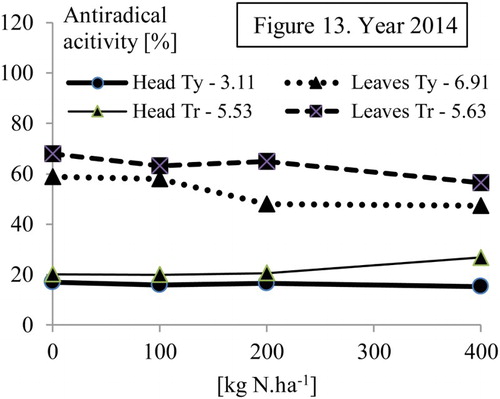
Figure 14. Effect of N treatment on antiradical activity (%) in cabbage heads and outer leaves, cv. Typhoon F1 (Ty) and Transam F1 (Tr). HSD (p = .05) in legend.
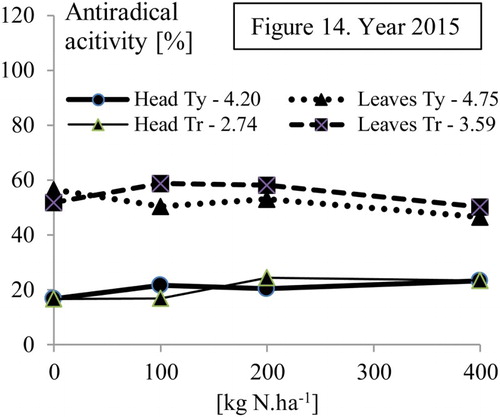
The total antioxidant activity (TAA) of cabbage (Brassica oleracea var. capitata) studied by Kaur and Kapoor (Citation2002) using the similar method (with β-carotene) and TAA method was found to be 69.3%. When the methanol extraction method was used during analysis of cabbage (Ismail et al. Citation2004), the evaluated TAA was on the level of 53.4%. The higher values of TAA – 96.00% – for cabbage outer leaves were received by Nilnakara et al. (Citation2009).
Presented studies indicate on significant effect of nitrogen fertilization on the total and marketable yield of the tested white head cabbage as well as weight of total cabbage heads. Basing on the analysis of content of some nutrients in two cabbage cultivars, it can be concluded that the outer leaves of cabbage head characterize with significantly higher nutritive value compared with marketable head. Although the outer leaves of cabbage are discarded after harvest and are treated generally as wastes, they possess high nutritive potential which can be practically used or transformed into an added value product.
Acknowledgements
This work was developed within the framework of the SUSFOOD I ERA-NET programme, project SUNNIVA (project no. 29) ‘Sustainable food production through quality optimized raw material production and processing technologies for premium quality vegetable products and generated by-products’.
Notes on contributors
R. Kosson received his Ph.D. degree in 1984 in Agriculture from Research Institute of Vegetable Crops, Skierniewice, Poland. Since 2004 he has been a Full Professor at the Research Institute of Horticulture, Department of Storage and Processing of Fruits and Vegetables, Poland. He has over 30 years of experience in research on the evaluation of vegetable and fruit quality and suitability for processing, MAP storage of perishable vegetables. He has contributed to research projects within 7th Frame Programme UE (QUAFETY, TRAFOON, SUNNIVA) as well as national projects (TRICHODERMA, HORTCOOL). R. Kosson is author of 219 scientific articles, including 83 peer-reviewed publications.
K. Felczyński, Ph.D. has been working at the Research Institute of Horticulture (InHort) in Skierniewice, Poland, Department of Vegetables Cultivation and Fertilization, as a Senior Researcher (adjunct). He received his Doctoral degree from InHort. He is involved in the area of field vegetable cultivation. Scientific interest is focused on agricultural aspects of vegetable cultivation in open field, such as fertilization, plant nutrition, irrigation, flat covering with plastic or fleece, plant density, study on new growing methods and many others. In 2012-2015 he contributed to the research project 'Trichoderma' and in 2014-2016 the 7th Frame Programme of UE project 'Sunniva'.
J. Szwejda-Grzybowska, Ph.D. graduated from Technical University of Łódź, Faculty of Biotechnology and Food Sciences. Since April 2004 she has been working at Research Institute of Horticulture (InHort), Department of Fruits and Vegetables Storage and Processing. Her area of interest is the assessment of quality, nutritional value of fresh, processed and stored vegetables. Since 2008 she is especially involved in research on influence of growing conditions, storage and postharvest treatments on the antioxidant properties of bell pepper. In 2016 Justyna Szwejda-Grzybowska received her Ph.D. degree from InHort, Skierniewice, Poland. She is the author or co-author of 15 scientific publications.
M. Grzegorzewska Ph.D. graduated from the Horticulture Faculty of the Agricultural University in Lublin. She obtained her Ph.D. in Agricultural Sciences in 1999 from the Research Institute of Vegetable Crops, Storage Laboratory, Skierniewice, Poland. She conducted research on storage of onion and cabbage vegetables as well as short-term storage of perishable vegetables. Dr Maria Grzegorzewska contributed to international research projects (QUALIMAN, QUAFETY and SUNNIVA) and some national ones. Her scientific interests concern issues related to the physiology of the post-harvest vegetables and the ways of post-harvest treatment and packaging. She is the author of numerous scientific and popular scientific publications.
L. Tuccio, Ph.D. received the first level of academic degree from University of Pisa, in 2004, the second level academic degree in ‘Science of Grapevine and Wine Technology’, University of Pisa, in 2007 and she achieved the PhD degree in ‘Crop Productions Science’, University of Pisa, University and Sant’Anna School of Advanced Studies in 2011. During the PhD she worked at the Wine Research Center, University of British Columbia, Vancouver, Canada, on the water management of vineyards (2010). She actually has a Post-Doc position at IFAC-CNR working on the ERA-NET SUSFOOD project. The areas of her interest are: Precision Agriculture, Food, Grape and Wine, optical sensors, and fluorescence spectroscopy. Number of scientific publications and proceedings: 23.
G. Agati received in 1983 the Doctor Degree in Physics from the University of Florence, Italy. Actually, he is a Senior Researcher at the Istituto di Fisica Applicata 'N. Carrara' of the Italian National Council of Research. He has large experience in the development of fluorescence and reflectance spectroscopic methods and sensors for plant status investigations. He possess competence in the application of portable optical sensors for the in situ detection of phytochemicals in fruits and vegetables. G. Agati is author of 85 peer-reviewed publications and more than 60 articles in conference proceedings. His Google scholar H index: 33, number of citations: 3781.
S. Kaniszewski is the Research Director and Full Professor in Research Institute of Horticulture, Skierniewice, Poland. His research interest concerns technology of vegetable cultivation, irrigation, plant nutrition, organic vegetable cultivation in open field and under cover, soilless cultivation of vegetables. He was coordinator or contractor of national and international projects such as Life +, EraNet, and Horizon 2020. Present research activity:contractor of the project 'Sustainable food production through quality optimized raw material production and processing technology for premium quality vegetable products and generated by-products' and 'Transfer of innovative techniques for sustainable water use in fertigated crops'.
Additional information
Funding
References
- Agati G, Tuccio L, Kusznierewicz B, Chmiel T, Bartoszek A, Kowalski A, Grzegorzewska M, Kosson R, Kaniszewski S. 2016. Nondestructive optical sensing of flavonols and chlorophyll in white head cabbage (Brassica oleracea L. var. capitata subvar. alba) Grown under different nitrogen regimens. J Agric Food Chem. 64:85–94. doi: 10.1021/acs.jafc.5b04962
- AOAC: Official methods of analysis, vol.1, association of official analytical chemists.
- Bartoszek A, Forc A, Grześkowiak J. 2002. Antioxidative properties of some vegetable products traditional for diets in Central Europe. Pol J Food Nutr Sci. 11:67–70.
- Biesiada A, Nawirska-Olszańska A, Kucharska A, Sokół-Łętowska A, Kędra K. 2010. The effect of nitrogen fertilization on nutritive value and antioxidative activity of red cabbage. Acta Sci Pol Hortorum Cultus. 9(2):13–21.
- Chen B-M, Wang Z-H, Li S-X, Wang G-X, Song H-X, Wang X-N. 2004. Effects of nitrate supply on plant growth, nitrate accumulation, metabolic nitrate concentration and nitrate reductase activity in three leafy vegetables. Plant Sci. 167:635–643. doi: 10.1016/j.plantsci.2004.05.015
- Chohura P, Kołota E. 2011. Effect of differentiated nitrogen fertilization on the yield and quality of leaf lettuce. Fol Hort. 23:61–66.
- Chohura P, Kołota E. 2014. Suitability of some nitrogen fertilizers for the cultivation of early cabbage. J Elem. 3:661–672.
- Chu YF, Sun J, Wu X, Liu RH. 2002. Antioxidant and anti-proliferative activities of common vegetables. J Agric Food Chem. 50:6910–6916. doi: 10.1021/jf020665f
- CSOP. 2014. Central statistical office of Poland. Warszawa, 2014.
- Dell Inc. 2016. Dell statistica (data analysis software system), Version 13.software.dell.com.
- Eberhardt MV, Lee C, Liu R. 2000. Antioxidant activity of fresh apples. Nature. 405:903–904.
- Engelbrecht GM, Ceronio GM, Motseki PM. 2010. Effect of nitrogen levels and sources on production of Swiss Chard (Beta vulgaris var. Cicla). SAfr J Plant Soil. 27:229–234. doi: 10.1080/02571862.2010.10639991
- Everaarts AP, de Moel CP. 1998. The effect of nitrogen and the method of application on yield and quality of white cabbage. Europ J Agron. 9:203–211. doi: 10.1016/S1161-0301(98)00038-0
- Feller C, Fink M, Laber H, Maync A, Paschold P, Scharpf HC, Schlaghecken J, Strohmeyer K, Weier U, Ziegler J. 2011. Düngung im Freilandgemüsebau. In: Fink M, editor. Schriftenreihe des Leibniz Institut fur Gemuse und Zierpflanzen-bau (IGZ), Ausgabe 3, Heft 4. Großbeeren.
- Freyman S, Toivonen PM, Perrin PM, Lin WC, Hall JW. 1991. Effect of nitrogen fertilization on yield, storage losses and chemical composition of winter cabbage. Can J Plant Sci. 71:943–946. doi: 10.4141/cjps91-135
- Gajewski M, Radzanowska J. 2004. Chemical composition and sensory quality of white cabbage depending on the cabbage cultivar and nitrogen dose as applied in mineral fertilization /in Polish/. Żywność Nauka Technologia Jakość. 39:108–120.
- Hatano A, Okawa H, Imagawa M. 2003. Effects of the amount of nitrogen application on the nitrate contents of cabbage and Chinese cabbage. Res Bull Aichi-ken Agric Res Center. 35:79–83.
- Ismail A, Marjan ZM, Foong CW. 2004. Total antioxidant activity and phenolic content in selected vegetables. Food Chem. 87:581–586. doi: 10.1016/j.foodchem.2004.01.010
- ISO 6557-2. 1984. Fruits, vegetables and derived products. Determination of ascorbic acid content. Part 2.
- Jahangir M, Kim HK, Choi YH, Verpoorte R. 2009. Health-affecting compounds in Brassicaceae. Compr Rev Food Sci Food Saf. 8:31–43. doi: 10.1111/j.1541-4337.2008.00065.x
- Jongaroontaprangsee S, Tritrong W, Chokanaporn W, Methacanon P, Devahastin S, Chiewchan N. 2007. Effects of drying temperature and particle size on hydration properties of dietary fibre powder from lime and cabbage by products. Int J Food Prop. 10:887–897. doi: 10.1080/10942910601183619
- Kaniszewski S, Rumpel J. 1998. Effects of irrigation, nitrogen fertilization and soil type on yield and quality of cauliflower. J Veg Crop Prod. 4:67–75. doi: 10.1300/J068v04n01_08
- Kaniszewski S, Rumpel J, Dyśko J. 1999. Response of late white cabbage to fertigation and broadcast nitrogen application. Veg Crop Res Bull. 50:21–30.
- Kaur C, Kapoor HC. 2002. Anti-oxidant activity and total phenolic content of some Asian vegetables. Int J Food Sci Technol. 37:153–161. doi: 10.1046/j.1365-2621.2002.00552.x
- Kołota E, Adamczewska-Sowińska K. 2009. Efficiency of ENTEC 26 – a new concept nitrogen fertilizer in white head cabbage production. Veg Crops Res Bull. 69:73–80.
- Kołota E, Chohura P. 2015. Control of head size and nutritional value of cabbage by plant population and nitrogen fertilization. Acta Sci Pol Hortorum Cultus. 14(2):75–85.
- Komiyama S, Furudate A, Meguro T. 1999. The current situation and factors affecting ascorbic acid content of summer harvested cabbage. Bull of Hokkaido Prefectural Agric Exp Stations. 77:65–68.
- Kramchote S, Srilaong V, Wasusri T, Wongs-Aree C, Kanlayanarat S. 2012. Low temperature storage maintains postharvest quality of cabbage (Brassica oleracea var. capitata L.) in supply chain. Int Food Res J. 19:759–763.
- Kurilich AC, Tsau GJ, Brown A, Howard L, Klein BP, Jeffery EH, Kushad M, Wallig MA, Juvik JA. 1999. Carotene, tocopherol and ascorbate contents in subspecies of Brassica oleracea. J Agric Food Chem. 47:1576–1581. doi: 10.1021/jf9810158
- Lee Y, Howard LR, Villaón B. 1995. Flavonoids and antioxidant activity of fresh pepper (Capsicum annuum) cultivars. J Food Sci. 60:473–476. doi: 10.1111/j.1365-2621.1995.tb09806.x
- Lisiewska Z, Kmiecik W. 1996. Effects of level of nitrogen fertilizer, processing conditions and period of storage of frozen broccoli and cauliflower on vitamin C retention. Food Chem. 57:267–270. doi: 10.1016/0308-8146(95)00218-9
- Maynard DN, Barker AV. 1972. Nitrate content of vegetable crops. HortScience. 7:224–226.
- Nilnakara S, Chiewchan N, Devahastin S. 2009. Production of antioxidant dietary fibre powder from cabbage outer leaves. Food Bioprod Process. 87:301–307. doi: 10.1016/j.fbp.2008.12.004
- Pongmalai P, Devahastin S, Chiewchan N, Soponronnarit S. 2015. Enhancement of the microwave-assisted extraction of bioactive compounds from cabbage outer leaves via the application of ultrasonic pretreatment. Sep Purif Technol. 144:37–45. doi: 10.1016/j.seppur.2015.02.010
- Rumpel J. 2002. Cultivation of cabbage. Warszawa: Hortpress.
- Sady W. 2000. Fertilization of field grown vegetables. Kraków: Plantpress.
- Sanchez CA, Roth RL, Gardner BR. 1994. Irrigation and nitrogen management for sprinkler-irrigated cabbage on sand. J Am Soc Hortic Sci. 119:427–433.
- Sieling ERM. 1992. Nitrogen fertilization guidelines for arable crops and field vegetables. Lelystad: IKCAGV.
- Singh J, Upadhyay AK, Bahadur A, Singh B, Singh KP, Rai M. 2006. Antioxidant phytochemicals in cabbage (Brassica oleracea L. var. capitata). Scientia Horticulturae. 108:233–237. doi: 10.1016/j.scienta.2006.01.017
- Smolen S, Sady W. 2009. The effect of various nitrogen fertilization and foliar nutrition regimes on the concentrations of nitrates, ammonium ions, dry matter and N-total in carrot (Daucas carota L.) roots. Sci Hort. 119:219–231. doi: 10.1016/j.scienta.2008.07.030
- Sørensen JN. 1993. Use of the N min-method for optimization of vegetable nitrogen nutrition. Acta Hortic. 339:179–192. doi: 10.17660/ActaHortic.1993.339.16
- Sørensen JN. 1999. Nitrogen effects on vegetable crop production and chemical composition. Acta Hort. 506:41–50. doi: 10.17660/ActaHortic.1999.506.4
- Sturm M, Kacjan-Marsic N, Zupanc V, Bracic-Zeleznik B, Lojen S, Pintar M. 2010. Effect of different fertilization and irrigation practices on yield, nitrogen uptake and fertilizer use efficiency of white cabbage (Brassica oleracea var. capitata L.). Scientia Horticulturae. 125:103–109. doi: 10.1016/j.scienta.2010.03.017
- Tarata G, Popandron N, Podoleanu M, Gavriliuc M, Munteanu. 1995. Studies on the effect of nitrogen fertilizers on cabbage and cauliflower. Anale Institutul de Cercetari pentru Legumicultura si Floricultura Vidra. 13:475–484.
- Turan M, Sevimli F. 2005. Influence of different nitrogen sources and levels on ion content of cabbage (Brassica oleracea var. capitata). NZ J Crop Hort Sci. 33:241–249. doi: 10.1080/01140671.2005.9514356
- Vinson JA, Hao Y, Su X, Zubik L. 1998. Phenol antioxidant and quality in foods: Vegetables. J Agric Food Chem. 46:3630–3634. doi: 10.1021/jf980295o
- Zebarth BJ, Freyman S, Kowalenko CG. 1991. Influence of nitrogen fertilization on cabbage yield, head nitrogen content and extractable soil inorganic nitrogen at harvest. Can J Plant Sci. 71:1275–1280. doi: 10.4141/cjps91-178
- Zhishen J, Mengcheng T, Jianming W. 1999. The determination of flavonoid contents in mulberry and their scavenging effects on superoxide radicals. Food Chem. 64:555–559. doi: 10.1016/S0308-8146(98)00102-2

